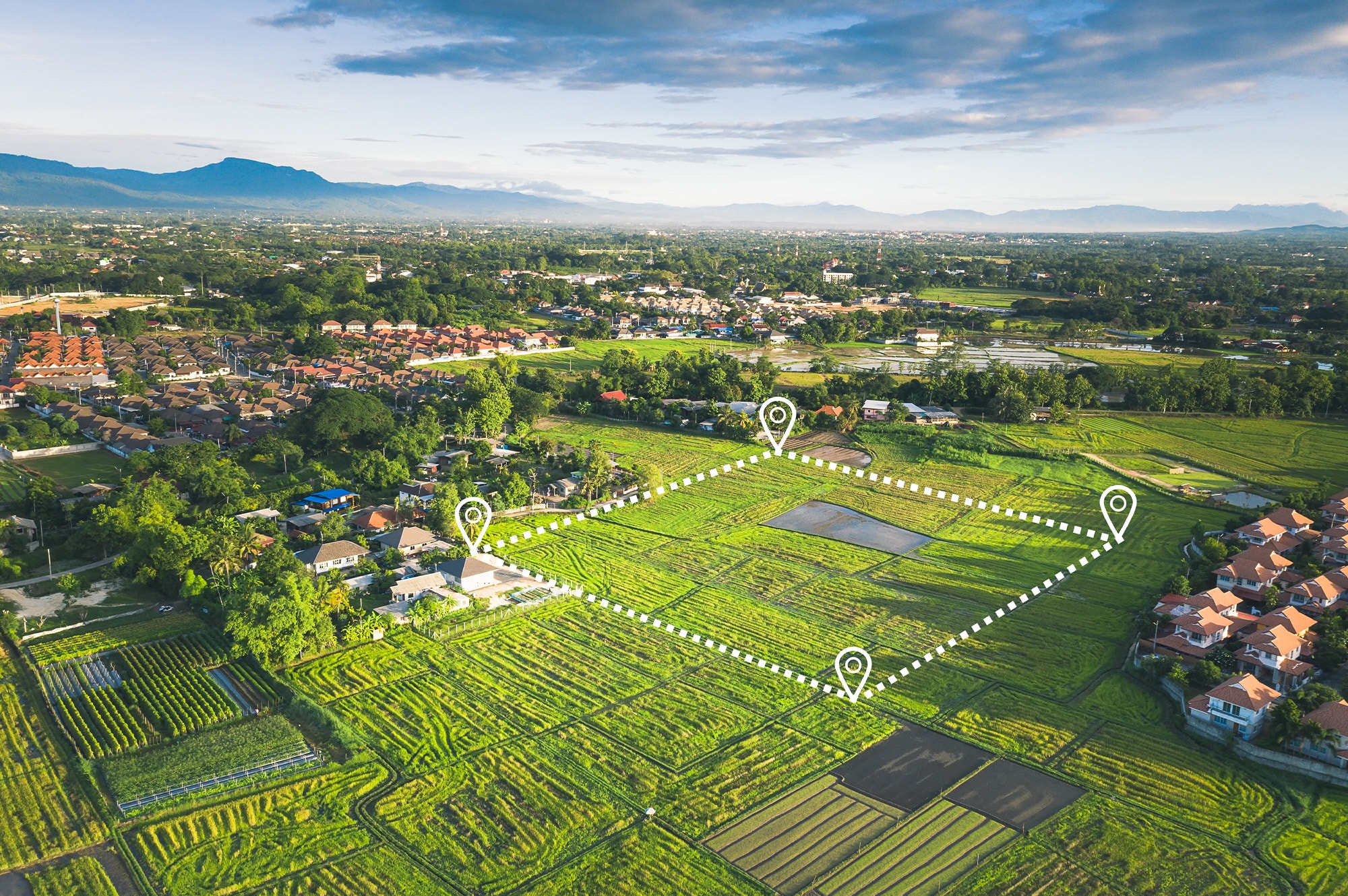Introduction
Definition: A land loan is a type of loan that helps you buy vacant or undeveloped land. It’s ideal if you want to buy land you can build on in the future, or you want to hold the land as a long-term investment.
A land loan isn’t quite the same as taking out a regular home loan. Vacant land doesn’t earn rental income and it is harder to sell if the market dips. Lenders generally see land loans as higher risk and impose stricter conditions like higher interest rates and/or bigger deposits. Lenders adopt a more conservative approach when extending loans for vacant land due to the higher risks associated with these loans.
If you need to talk with a trustworthy mortgage broker to find a suitable land loan, check out the top 10 list of the best mortgage brokers for your area:
How do Land Loans Work?
Land loans are designed to help you buy a block of land without an existing house on it. Unlike a typical home loan, they only cover the cost of the land itself, not any construction you may do later.
Because there’s no house to act as security, lenders have tighter rules on lending, such as:
- Generally higher interest rates (usually 0.5-2% above standard home loans)
- Larger deposits (typically 20-30%)
- Stricter lending criteria (they assess factors like the land’s location, size, zoning, and access to services)
- Shorter loan terms in some cases (often 5-20 years, although some lenders may offer terms of up to 30 years)
These conditions vary between lenders, but understanding the stricter rules will help you plan ahead and find a loan that fits your goals.

“Each lender has their own criteria for approving land purchases, including specific conditions that may apply. Some lenders don’t permit land banking and may require you to begin construction within a certain timeframe. Speak with your broker to find the most suitable lender for your land purchase.“
Mansour Soltani, Soren Financial

Types of Land Loans in Australia
Not all land loans are the same. It depends on what land you’re buying, where it’s located, and what you plan to do with it. Here is a breakdown of the most common land loan types in Australia.
Vacant Land Loans
Definition: A vacant land loan is used to buy a block of land that doesn’t have a house on it, when you have no immediate plans to build. This means the land will remain vacant for a period.
What to expect:
Vacant land loans are usually available for residential, rural, or even some commercial-zoned land
Most lenders ask for a deposit of 20–30%
Interest rates tend to be higher than regular home loans (often by 0.5–2%)
The land needs to be in an accessible area. Remote blocks or those without utilities may be harder to get financed
Some lenders may require you to start building within 1 to 5 years, so always check the terms
Vacant land loans can be a good fit if you’re thinking long-term and you want to hold off on constructions for a while.
House and Land Packages
Definition: A house and land package is a bundled deal where you buy the land and the house together, often through the same developer or builder.
What to expect:
You’ll usually get a fixed price for both the land and the build
Many lenders offer better terms than they would for a standalone land loan
Deposits can be lower, sometimes 5–10% if you qualify for Lenders Mortgage Insurance (LMI)
You may be eligible for first home buyer grants and other government incentives
Most lenders want you to sign a fixed-price building contract before approving the loan
Loans often come with a fixed term, where the interest rate is set for a specified period before transitioning to a variable rate
House and land packages are common in new residential developments and master-planned communities. They’re a great option if you want a simpler, more structured path to building a new home.
For more information on buying your first home, check our comprehensive first home buying guide.
Land and Construction Loans
Definition: Land and construction loans are two-part loans that cover both the purchase of your land and the cost of building the home.
This type of loan usually works in stages. First, the loan covers what you need to buy the land. Then, as your home is built, your lender releases money in instalments to your builder, in a form known as “progress payments”.
What to expect:
The loan starts as a land loan and becomes a construction loan once building begins
The lender releases funds gradually at key construction stages (like slab, frame, and lock-up)
You usually only pay interest on the amount that’s been drawn down
Once the build is finished, the loan switches to a standard home loan with principal and interest repayments
You’ll need a fixed-price building contract to get approved, as lenders want cost certainty
After the fixed rate period, the loan reverts to a variable rate, which can affect your repayment amounts
This option works well if you’re planning to start building soon and want to stay in control of the process from start to finish. You can learn more about the property buying process in our steps to buying property guide.
Rural or Regional Land Loans
Definition: Rural or regional land loans are designed for larger blocks outside major cities, and are often used for lifestyle properties, acreage, or hobby farms. They come with different risks and requirements compared to regular land loans.
What to expect:
Suitable for larger land parcels, usually over 2 hectares
Used for lifestyle properties, hobby farms, or mixed-use land
Most lenders require bigger deposits, often 20–30% or more
Lenders may need extra checks like land use reports, zoning approval, or environmental assessments
Lenders may also assess utility access, road access, and water rights
Not all lenders offer rural land financing, and those that do may have stricter conditions. The Rural Bank and Rabobank are two lenders that specialise in these types of loans.
SMSF Land Loans
Definition: This loan allows Self-Managed Superannuation Funds (SMSFs) to borrow money to buy land as an investment under specific regulatory conditions.
What to expect:
The loan must follow superannuation rules and use a Limited Recourse Borrowing Arrangement (LRBA)
You can’t live on or personally use the land, it’s strictly for investment
Deposits are usually higher (often 20–40%)
Interest rates and fees tend to be higher than regular investment loans
You’ll need legal and financial advice to make sure you stay compliant
SMSF land loans come with strict regulations and are best suited to experienced investors. For more information on using your SMSF for property investment, see our guide on buying property using SMSF.

Buying Land
Choosing the Right Location
When buying land, choosing the right location is an important factor to consider. The location of the land can affect its value, usability, and potential for development. It’s essential to research the area, considering factors such as zoning regulations, land prices, and the potential for future growth. A land loan can be used to purchase a vacant block of land, which can be used for various purposes, including building a dream home or generating rental income as an investment property. Most lenders offer land loans with competitive interest rates, but it’s crucial to compare rates and terms to find the best option.
Legal and Environmental Considerations
Before purchasing land, it’s essential to consider legal and environmental factors. This includes researching any zoning restrictions, environmental concerns, or unexpected costs associated with the land. A thorough inspection of the land, including soil tests and surveys, can help identify potential issues. Additionally, it’s crucial to review local zoning regulations to ensure the land can be used for the intended purpose. A vacant land loan can be used to purchase land for residential use, but it’s essential to ensure the land is not located in a flood-prone area or has other environmental concerns.
Negotiating the Purchase
Negotiating the purchase of land requires careful consideration of several factors, including the price, terms, and conditions of the sale. It’s essential to work with a reputable real estate agent or attorney to ensure a smooth transaction. A land loan can be used to finance the purchase of vacant land, and most lenders offer competitive interest rates and terms. However, it’s crucial to compare rates and terms to find the best option. A higher deposit can result in lower interest fees or better interest rates, so it’s essential to consider this when negotiating the purchase.
Eligibility Criteria for a Land Loan
Getting approval depends on a mix of criteria, such as your deposit, income, financial situation, and aspects of the land itself. Here’s what lenders generally look at.
Deposit Requirements
Usually a larger upfront deposit than standard home loans is required, and the amount depends on the land’s location and type:
Metro residential land: 20% minimum deposit
Regional land: 20–30%
Rural or acreage blocks: 30% or more
SMSF purchases: 20–40%, depending on the lender and property type
Some lenders may offer high loan-to-value ratio (LVR) loans with as little as 10-15% deposit for well-located residential blocks, but these often require lenders mortgage insurance (LMI). For regional or rural land, some lenders don’t offer LMI at all, which means you’ll need to meet the full deposit requirement upfront.
The Land You’re Buying
Lenders also look at the land itself when deciding your eligibility for a loan. You’ll have a better chance of approval if the land:
Is zoned for residential use
Is under 2,000m² in size
Has access to utilities like water, electricity, and sewage
Is located in a metro or established regional area
Has good road access and isn’t on steep or flood-prone land
Is registered land, fully prepared for development with all necessary infrastructure in place
Your Financial Position
Like with any loan, your ability to repay what you borrow is key to being approved. Lenders determine the maximum loan amount based on several factors, including your financial position. They look for:
Steady income and secure full-time employment
A clean credit history (score above 650 is preferred)
Low debt compared to your income
A record of genuine savings (usually over 3–6 months)
Realistic living expenses that leave room to afford repayments
Your Plans for the Land
If you plan to build on the land, that can help your application. Lenders may favour:
A general construction timeline (within 1–5 years)
Any early discussions with builders or planners
Development approvals or permits, if available
Having plans to build within a few years can positively influence loan approval. The clearer your building plans, the better your chances of getting approved.

Land Loan Interest Rates & Fees
Land loans work a little differently when it comes to rates and fees. Here’s a quick overview of what you need to know. It is crucial to consider comparison rates when evaluating loan options, as they reflect the true cost of a loan by including fees and charges.
Fixed vs. Variable vs. Split Options
Most lenders offer fixed, variable, or split loan options for land loans:
Fixed rates: You can lock in your interest rate for a set period (usually 1-3 years for land loans, shorter than normal home loans). Once the fixed period ends, the loan usually switches to a variable rate. Fixed loans may limit extra repayments and could come with break costs if you end the loan early.
Variable rates: These rates can go up or down depending on the market. They offer more flexibility – like the ability to make extra repayments or pay off the loan early without penalties – but your repayments could increase over time. Once the fixed rate period concludes, the loan automatically reverts to a variable rate loan, influencing repayment amounts and potential costs associated with that change.
Split loans: A combination of fixed and variable. Part of your loan stays predictable, while the other part remains flexible. This can be a good option if you want a balance between stability and freedom.
For more information on each type of interest rate structure, see our full article on fixed, variable, and split loans.
Rate Comparisons
Interest rates are typically higher than standard home loan rates due to perceived higher risk:
Vacant land loans: 0.5-2% higher than standard variable home loan rates
House and land packages: 0.25-0.75% higher
Land and construction loans: Variable rates during the build, then standard rates after
Rural land loans: 1-2.5% higher
SMSF land loans: 2-3% higher
Don’t just check the interest rate when applying for a loan. The comparison rate includes fees so it gives you a clearer picture of the loan’s overall costs. Different terms, fees, and loan amounts, such as a standard loan amount of $150,000, can significantly affect the comparison rate.
Common Fees
Land loans often incur additional or higher fees compared to standard home loans. Here’s a breakdown of the fees you’re most likely to come across:
Application fees: $150–$700 (may be waived in package deals)
Valuation fees: $300–$1,000+ (higher for rural properties)
Legal and documentation fees: $200–$500
Title search fees: $50–$200
LMI (applies when borrowing above certain LVR thresholds. Premiums vary)
Progressive drawdown fees: $150–$350 per drawdown (for construction loans)
Annual package fees: $300–$400
It’s important to budget for additional expenses such as legal fees when planning your purchase.
According to Canstar, you’d usually pay around $800-$1,200 in upfront fees for a standard home loan. However, fees are higher for land loans, especially for rural or complex properties.
For personalised advice about mortgage options and fees, consider consulting with a mortgage broker in Sydney, Melbourne, or Brisbane.

Building and Construction
Planning Your Build
Planning your build is a critical step in the construction process. This includes creating a detailed floor plan, obtaining necessary permits, and hiring a reputable builder. A construction loan can be used to finance the building process, and most lenders offer competitive interest rates and terms. However, it’s essential to compare rates and terms to find the best option. A fixed-price building contract can help ensure the project stays on budget, and progress payments can be made as the construction progresses. A land loan can be used to purchase the vacant block of land, and then a construction loan can be used to finance the building process. It’s essential to consider the interest rate and repayment terms when choosing a loan, as well as any ongoing fees or charges.
How to Apply for a Land Loan in Australia
Applying for a land loan is similar to a standard home loan, but with a few extra steps depending on the type of land and your future building plans. These loans are often sought by individuals looking to purchase vacant land for future construction or as an investment. Here’s a simple breakdown of how it works.
Step 1: Get Pre-Approval
Before you start shopping for land, it’s a good idea to get pre-approved. This gives you a clear budget and shows sellers you’re a serious buyer. Your mortgage broker or lender will look at your income, expenses, credit history, and financial goals to give you conditional approval, which is usually valid for 3 to 6 months. This is usually dependent on certain land criteria, such as zoning, size, and location of the land.
Want to learn how the pre-approval process works? See our article on mortgage pre-approval.
Step 2: Gather Your Documents
You’ll need to supply a few key documents to get your land loan approved. These usually fall into three main categories:
Personal ID – like your driver’s licence, passport, medicare card, and proof of address
Financial information – recent pay slips, bank statements, tax returns, and any existing loans
Property details – the contract of sale, land title, zoning reports, and any building plans you have
Your mortgage broker or lender can give you a full checklist based on your situation, so don’t stress too much about gathering all your documents upfront.
Step 3: Submit Your Application
Once you’ve chosen your land and got all your documents ready, it’s time to submit your application. After you’ve submitted it, your lender will assess your loan before deciding on approval.
This usually involves a property valuation, a credit check, and a full review of your finances and the land details. The full process usually takes 2 to 6 weeks, depending on how complex your application is and how quickly your lender processes everything.

Things to Consider Before Buying Land
Before you apply for a land loan, here are a few key factors that could affect your plans. One important consideration is securing your dream block, which allows you to acquire your ideal plot of land without the immediate requirement to start construction.
Council Zoning and Building Restrictions
Definition: Zoning regulations are local government rules that determine how land can be used and what structures can be built on it.
Check with the local council to confirm the zoning before you buy. Some blocks have extra rules around building height, how close you can build to the boundary, or even what style of home you can build – especially in bushfire zones, flood areas, or heritage-listed neighbourhoods. Additionally, some lenders may require you to begin construction within a specific period.
If you’re unsure about restrictions, a local council or planning consultant can help. For further guidance through the legal aspects of land purchase, you can also consult with experienced conveyancers in Sydney, Melbourne, or Brisbane.
Access to Utilities and Infrastructure
Definition: Infrastructure access refers to the availability of essential services like water, power, sewerage, and internet.
Land without essential services can cost tens of thousands of dollars to connect, and may not be eligible for finance until they’re connected and land is ready to build on.
Soil Testing and Site Preparation
Definition: Soil testing is a process of analysing ground composition to identify conditions and whether any extra site preparation is needed for building.
A soil or contour survey can uncover hidden costs like retaining walls, drainage, or excavation. While these can be expensive ($1,500–$3,000 for both soil testing and contour surveys), they’re well worth it before signing a contract. They save you thousands in unexpected build costs and help you avoid buying a block that’s expensive or difficult to build on.
Bushfire, Flood, and Other Risk Areas
Definition: These risk zones are areas identified by local authorities as being more likely to experience natural hazards like bushfires, floods, or erosion.
If your land is in one of these zones, you may need to meet stricter building regulations, use special materials, or raise the floor height. All of these can increase your construction costs and lead to higher insurance premiums once the property is built.
Resale and Valuation Risks
Definition: Resale and valuation risk refers to the chance that the land may not increase in value as expected, or it might be difficult to sell.
Vacant land is often harder to price than established homes, especially if there haven’t been many recent sales nearby. It can also take longer to sell, particularly in rural areas or when the market slows down. If you’re not planning to build soon, think carefully about how long you’re prepared to hold the land.
To minimise your risks, consider working with expert buyers agents in Sydney, Melbourne, or Brisbane who understand local market dynamics.

Pros and Cons of Land Loans
Land loans can be a great way to secure a block of land before you’re ready to build, but they come with unique terms and conditions. The table below gives you an overview of the pros and cons of land loans.
Advantages of Land Loans | Disadvantages of Land Loans |
|---|---|
Buy now, build later Gives you time to plan, save, or find the right builder without needing to build straight away. | Higher interest rates Usually 0.5%–2% higher than standard home loans due to higher risk. |
Lower upfront cost than a house Buying land typically requires a smaller initial outlay compared to a full property purchase. | Bigger deposit required Most land loans require a 20–30% deposit, sometimes more for rural or unusual blocks. |
Can be paired with a construction loan Many lenders offer combined land and build finance packages. | Stricter lending criteria Approval depends on zoning, access to services, location, and block size. |
Interest-only options available Some lenders allow interest-only payments during the holding period. | Fewer lenders available Not all banks offer land loans, especially for regional or unregistered land. |
May qualify for first home buyer benefits Some government grants or stamp duty concessions may apply. | No rental income You’ll need to cover the loan and holding costs without income from the land. |
| Time limits to build Some lenders require you to start building within 1–5 years of settlement. |
| Land only loans Lenders often perceive these loans as riskier due to land price fluctuations, leading to requirements for larger deposits and potentially higher interest rates. |
Alternatives to Land Loans
If you don’t feel a land loan is right for you, there are alternative ways to finance your land purchase. One such option is a land mortgage, which can be particularly useful for those planning future development or investment.
Redraw from Your Existing Mortgage
If you already own a property with equity, you may be able to access funds through your current home loan. This often comes with lower interest rates than a standalone land loan, no new application fees, and no pressure to build within a specific timeframe. Just make sure your serviceability still stacks up.
Personal Loan
For small land purchases (typically under $50,000), a personal loan might work. These are faster to arrange, don’t require property as security, and have shorter loan terms (usually 1–7 years). While interest rates are higher, you may pay less overall if you repay quickly.
Buying Established Property Instead
Instead of buying vacant land, consider purchasing an existing home you can live in or rent out, before you eventually knock down and rebuild. This path gives you immediate income potential, access to standard home loan products, and more financing options.

Final Tips for Getting the Best Land Loan Deal
These tips can help you avoid common mistakes and potentially save you thousands in the long run.
The deposit required for a land loan will vary based on the cost of the land being purchased and the lender’s policies.
Find a Mortgage Broker Who Specialises in Land Loans
Not all mortgage brokers understand the ins and outs of land lending. A broker who specialises in this area can help you find lenders that suit your block’s zoning, location, and future building plans, particularly if you’re buying in a regional area or the land isn’t straightforward.
Look for Lenders with Rural and Regional Lending Experience
If you’re buying outside a metro area, some lenders will be a better fit than others. Banks that regularly deal with regional properties often have more flexible lending policies, better valuation approaches, and a clearer understanding of timelines and local planning issues.
Always Factor in Long-Term Building Plans and Future Lending
The best loan isn’t always the one with the lowest rate today. It’s the one that supports your full journey, from buying the land to building your home. Look for lenders who can offer a smooth transition to a construction loan, and consider how changes in costs or interest rates could affect your plans.
Conclusion
Buying land can be an exciting step toward building your dream home or securing a long-term investment, but it does come with a few more hoops to jump through than a standard home loan.
Land loans usually come with bigger deposits, higher interest rates, and stricter lending criteria than standard home loans. Before you decide on which land to buy, invest time in research, professional advice, and carefully consider whether the land is easy to finance – and whether it suits your future plans and financial position.
Finding a land loan is much faster and easier with a trustworthy broker. Check out the top 10 list of local mortgage brokers for your area:

MANSOUR SOLTANI
With over two decades of experience in Australia’s real estate sector, Mansour has built a career specialising in the acquisition and sale of investment and commercial properties, spanning major metropolitan hubs and regional areas. As the founder and owner of a finance brokerage firm, he manages a loan portfolio exceeding $100 million while serving a broad range of clients nationwide.
A frequent contributor to money.com.au, Mansour has developed a deep understanding of diverse investment strategies, enabling him to provide valuable, well-informed perspectives on market trends and opportunities.
